POULTNEY—When it comes to building a living space, how small can you go? Three years ago, professor Lucas Brown’s students in Green Mountain College’s Renewable Energy and Ecological Design (REED) class built a custom-designed tiny house, a 96-square-foot structure with a sleeping loft “upstairs” and a 300-watt solar powered electrical system.
This semester, his class went one better, constructing a 70 square-foot “living system” that can be towed on a standard 5X8 foot trailer. The pod-shaped tiny house includes indoor plumbing in the form of a composting toilet, a rainwater collection system, and a single 120-watt solar panel to provide electricity. The class has dubbed the structure OTIS (Optimal Traveling Independent Space).
The class of 16 students challenged itself to design and build a living space with enough room for one person, that could be easily towed behind a typical 4-cylinder vehicle, and could provide its own water and electricity.
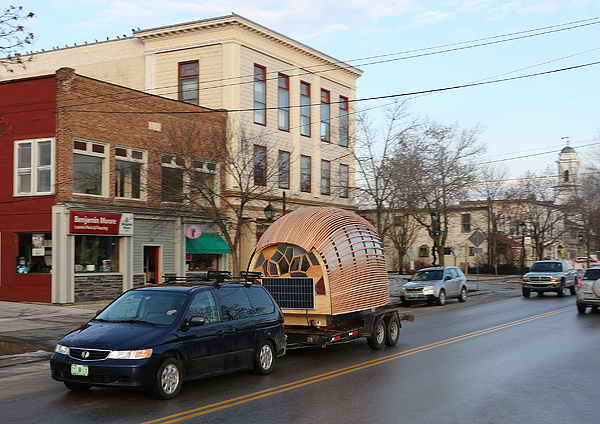
Environmental sustainability is the foundation of the college curriculum, and REED students are interested in finding ways to reduce consumption of fossil fuels and leave a smaller ecological footprint. But Brown thinks there is something more at work behind his students’ enthusiasm for the project.
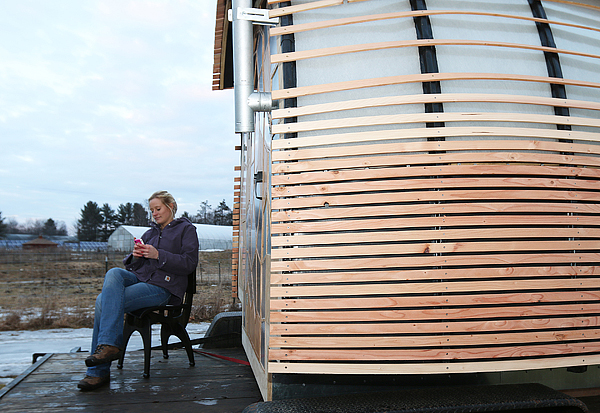
“The appeal of living a more nomadic lifestyle represents a new take on the American Dream, especially among students in this millennial generation,” he said. “Lots of writing on the millennials suggests that our suburban growth model perpetuated over the last 50-60 years is starting to come to and end. They (students) aren’t interested in being tied down with rent or a mortgage right after college. Something about having their own living space which is very low maintenance and very mobile suggests a different set of priorities.”
“It’s got its own solar system to power itself, and a bath and kitchen are independently supplied by rainwater,” said senior Mike Magnotta. “At the end of the day, you just need the environment to sustain yourself. You’re not tied down to a piece of land and be stuck somewhere. You can really go anywhere and do anything.”
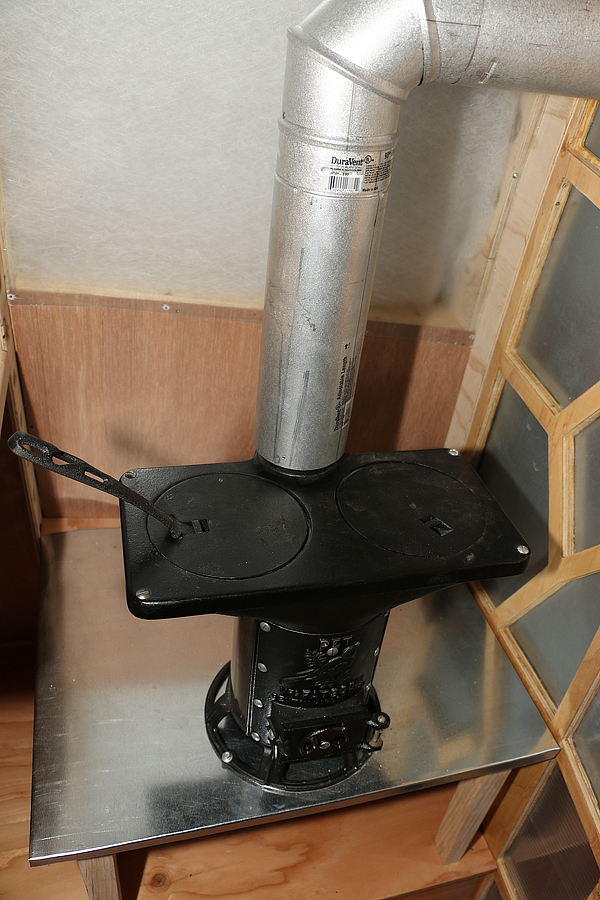
Students broke into teams to study and develop water, energy, heat, and building envelope systems. Kellin Banks was charged with managing the water systems. “How to turn something that most people don’t want to think about into a valuable resource—that was an interesting challenge,” she said.
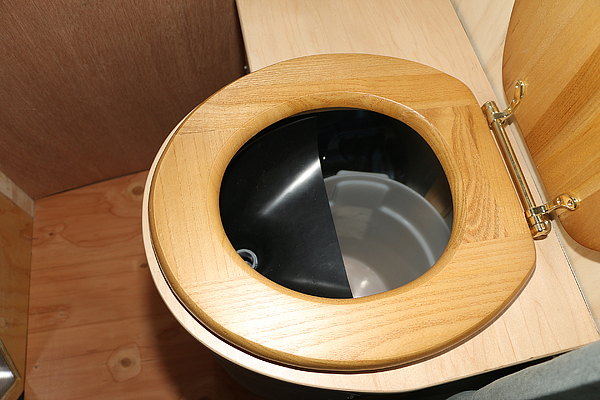
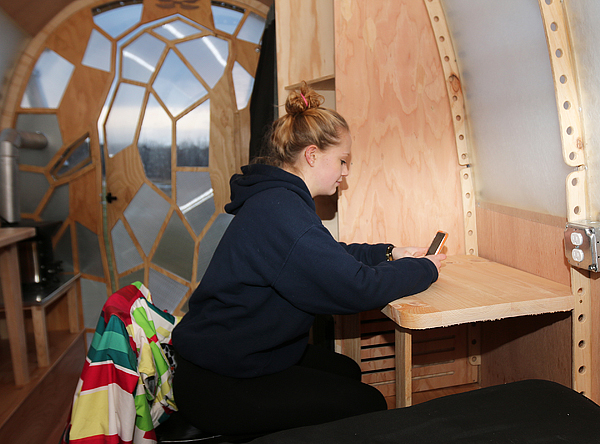
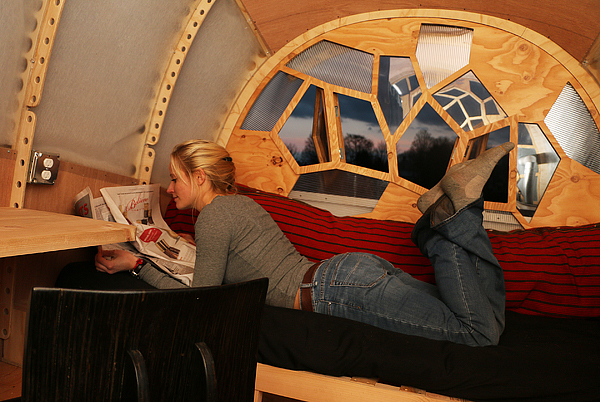
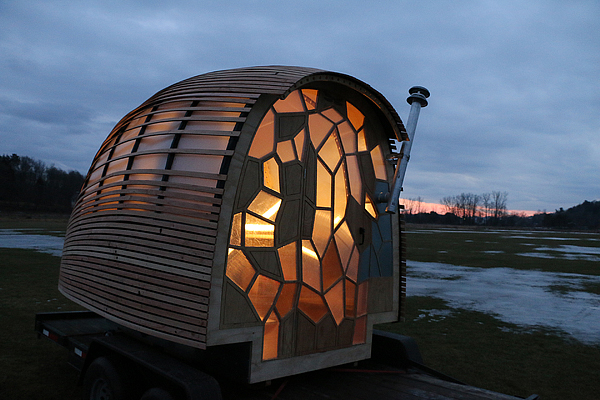
I think you make a mistake by not letting us to forward you news letters…
That would help expand readership.
Ron
Yes Ron . It would be GREAT to share easily . I have spent an hour trying to find HOW I can. So I went to the video , went to Youtube , and sent a FB share from there. The video does NOT have all the info in the article . SO I still wish I knew how to SHARE the article in it’s entirety.
Does anyone know how? Please tell us.
Thanx
Nakemo –
Not sure what aspect of the page or the blog you are trying to share and I apologize in advance if you know all this already.
The video on the page has a sharing function in the upper right corner – it is standard with a YouTube video player (click the “>” to get the sharing features). You can share just the video in this way to any of those services.
WordPress allows you as a standard to share to WordPress, Twitter, Facebook and Twitter, when you add a post to any of their blogs, so I’m assuming since this blog is embedded into the Tiny House Blog site, that those sharing buttons have been disabled in some way by whomever is handling the maintenance of the tinyhouseblog.com site. That individual(s) would need to add those sharing capabilities back into the blog page in order to share the whole blog post.
Hope that was helpful . . .
Susan
Beautiful! I’d live in it for sure.
What is the name of the stove and who sells it,
The stove looks like a Fatsco “Pet” – Fatsco appears to have a basic website at http://www.fatscostoves.com.
http://www.fatscostoves.com/
Interesting design. Looks like it is built to fit in a pickup truck bed as well as deposited on the ground.
One real concern I have is the wood stove pipe has 2 elbows. Having used wood heat for the last 38 years as a main heat source I have dealt with creosote build up quite a lot. Keeping pipes straight and short minimize the build up. Then cleaning the pipe out every week.
That can be easily fixed with DIY creosote traps.
I agree the elbows cause ‘build up’. [ I have heated with wood for 32 years ] . BUT , they also slow down the loss of heat , and obviously give alternative paths [ as opposed to a simple house installation]. As well as , the type of wood used can prevent creasote , also burn away creasote. I am sure less wood is used in this situation as well. I WOULD advise to ONLY use non-build up wood. AND hang a Fire extinguisher / or have 5 gallons of water VERY handy , as I do.
“You’re not tied down to a piece of land and be stuck somewhere. You can really go anywhere and do anything.”
We humans are social creatures who need to be in social groups called communities.
When we commit to communities, our communities are permanent and strong. If we are mobile, our communities weaken and eventually dissolve.
Mobile living is NOT sustainability!
Hi , I guess we will agree to disagree
Are you sugesting the Nomadic life is NOT community or sustainable ? Ask any Gypsey-Tibetan mountain person- Native American- Aboriginal Austrailians- etc.
Community is NOT found within ‘gated communities-Condo’s- etc. Most those people hide to themselves not having ANYTHING to do with their neighbors.
As far as sustainability , this model is an excelant example of Ecological/sustainable living.
Remember the ‘Wagon Train’? Was that community?
Thank you
I agree that community can be found in a mobile construct, but I do think it is more difficult–especially when hitting the road alone. One can surely build great ties in every area though! I also agree that many static living conditions, and our society in general, are non-conducive to community growth.
It is possible to have great experiences either way, and even to hybrid the two.
can we get plans for this? Now? thanks
I love this! Will you make another? What is the cost to build? I think your students have just created a company.
I see an issue with heating so small a space with a wood heater.
The fire would have to be small enough to not overheat the place but still large enough to have a decent bed of coals to keep it going.
And there does not seem to be much thermal mass associated with the heater, or much insulation on the structure.
Also, who is that blond reading the newspaper in the second picture?
I agree. I own a tiny stove [ it would fit inside most microwaves,w/o its legs]. it is a CONSTANT job to keep it going . Yet it would heat a tiny place as this . and provide heat as a person cooks.
I also agree on the insulative UN-quality . I would only live in the warm areas with this model , EVEN tho they built it in a snow country
Thanx
of course with the solar panel , alternative electric heat can be used to keep warm
Using a small solar panel to store electricity in a small battery pack for heat is very inefficient. The size of the batteries would be a negative on the design.
While I like the look, 70 sq. feet I not enough living space. I would think a minimum would be 120 sq. feet for one person, or 200 sq. feet for two (since two can share bathroom and kitchen areas, etc. Long term use of a small space could lead to claustrophobia or other disorders, especially when you are cooped up during winter months. Also, is there any insulation I this tiny house?
Amazing. Are you selling this and what would the cost be? Just wonderful that these students are learning the importance of the ecosystem.
Next step: make it easy to build with readily available materials… That door is funky looking but does not look simple to build.
love it! younger people are finding out about real freedom from debt.
Hi
I would very much like to buy the model OTIS, or another just like it. We are starting a LOL (little old lady!) Community in and on our little white farmhouse and (heaven s) half-acre in moyock NC next year, and your OTIS would be just perfect for us!
If the students were willing to sell their OTIS or an OTIS to us, we would then figure out how to transport him to here.
I especially love OTIS s great beauty … in particular the exterior wood and the unique style of the door? /wall? I m imagining the beauty of a small OTIS community with a small main house (like ours!) for all to share.
You probably noticed – I am very passionate about tiny home living!
Sincerely and cordially,
Janice Forest Feagan
757 777-6020 (cell and text)
Mimi4kgj@hotmail.com
Janice, as a older person 65, I love your housing plans. since women earn so little compared to men, it helps to stretch our dollars by banding together is community groups of our own. I really am interested in what you have planned at your farm. may I contact you at the email you gave. I love NC and have a small parcel in MO 6.6 acres which I was thinking about a similar idea. you seem farther ahead in planning and fore thinking than I am. thanks so much for the comments you left here. hunter
Hi Hunter
You certainly may contact me.
Jan
Great ideas from thes young people with an exciting vision.
Just because they want mobile freedom, does not mean they don’t have community. I am amazed at the number of friends my 20-something son has all over the world, and they connect when in each other’s back yards.
It is not the same world we grew up in, so we need to think differently. Give it a try!
Could you please post the school website in the comments or in the article? It disappears after the video.
Thanks for the great articles and inspiration your blog provides.
Oops, the link is in the first paragraph, sorry I missed it when it came up on the mobile article!
Congratulations. You built an RV.
Nah, rv’s have to hooked to all the utilities.
Go to your favorite search engine and look up ‘boondocking’, it’s long term camping with no utilities.
Can you easily load water for when there is no rain?
Where did you get your toilet urine diverter? I am interested in buying one. Thanks!
This build appears to have more emphasis on art design than actual habitat.
Insulation factor appears low also.
The curve is appealing, but not user friendly for quick construction.
I am 55 years old (Baby Boomer trying to figure out my retirement years). I think its a great idea these students had, but lets take this a step further. Wouldnt it be great if high schools or Tech schools taught kids how to build their own homes and the fundamentals of green living and off the grid living? Lets take it a step further yet, what if these high schools and tech schools could help design and build homes for baby boomers. I sure dont have a problem building my own place but I need tools and guidance.
I have been dreaming for years about buying about 20 acres and putting up about a 900 sq. foot cabin/home with solar energy. I would invite my friends and family to buy a piece of my property and do the same. We would be a small group of these kind of homes. I am not sure where to start with this process. Any ideas would be great. I live in the Atlanta, GA area.
Great job students, keep up the good work!
I have a handy man with knowledge, tools and will travel and build all you want, message me anytime. Were building mine now, have a blessed day
I love it! I, personally, might do something different with the door and windows but, I think this concept is great. I lived on a 30′ boat for almost 3 years with probably half the space that this has and enjoyed every minute of it. I would like to know more about it and whether or not any plans would be available for a build-your-own. Keep up the good work, Green Mountain!
Two thoughts after seeing the pictures: it’s beautiful. And: the cube is the best shape for a tiny home. Unless I am able to change stylish beautiful houses like I do fashionable clothes, I want more space inside given the footprint. It sure looks great though…..
it would be really nice if the “tiny house movement” would cater to families…and not just single individual’s. I’d like to see more ideas/houses that cater to families. It’s fascinating but unrealistic at times…
NIce update on a small travel trailer. Curves may help with the towing at higher speeds but you lose a lot of interior space.
It’s pretty.
why was it made to look so peculiar? I like the concept. but not crazy about the looks as a dwelling.
This is a great way to introduce young people to the problems of small portable living arrangements and tools. It is a pretty example of a small camper but I don’t see technical innovation on any scale.
Instead of that stove, which is very polluting and inefficient, it would be better to invest in a marine stove, a Dickenson perhaps, that burns cleaner and safer. A Dickenson marine wall mount stove can be vented to use outside air which means you burn much less fuel for the same warmth, and even the small ones burn for hours. That Tiny Fatsco stove uses inside air which means it needs an open window or door to function. A Dickenson wall mount heater, coupled with a small rocket stove that could be used outdoors for cooking in most weather, would be a much more efficient use of fuel you have to carry with you.
Realistic claims are necessary to promote new ideas to the public. 70 square feet times a half an inch of rain a day (assuming you collect it all) is only 19 oz. so it is a stretch to say it ‘generates’ it’s own water.
It is simply a variation on a camper built for boondocking. That’s not bad but it isn’t anything new. Boondockers have been using solar, wood, and composting toilets for decades.
Search under boondocking or dry camping and you’ll find tons of problems already solved, then you can try to come up with something that fits your needs.
Nice looking and somewhat aerodynamic but that all comes at a heavy price for interior space. Living in it for an extending length of time would help sort out problems and suggest practical improvements.
I will have to respectfully disagree. My name is Robert and I’m the student who designed the water collection system. Before I explain how I got my numbers I would like to ask: how did you achieve yours?
This site http://ga.water.usgs.gov/edu/earthrain.html provides information regarding how much water is in an inch of rain over certain surface areas. One example is for 1” of rain over a 70’x40’ roof, the amount of water is (as stated by the site) 1,743 gallons. This works out to be 2800 square feet, 40 times the size of our 70 Square foot living system (OTIS). So simply dividing 1,743 by 40 gives an answer of 43.575 gallons. This is the total water put on OTIS from 1” of rainfall. So dividing this 43.575 by 2 gives us the total water from ½” of rain, the answer being 21.7875 gallons. This is quite different from your answer of 19oz, so again I will ask you to explain your calculations.
As well there is a calculator on the same site to determine how much water is produced http://ga2.er.usgs.gov/edu/activity-howmuchrain.cfm .This provides an answer of 22 gallons for a ½” of rain over a 70sq. ft. area; a slight deviation (in my favor) from my calculations.
For some additional information the average annual precipitation for VT (where OTIS is currently residing) is 42.7” (http://www.currentresults.com/Weather/US/average-annual-state-precipitation.php) divided by 12 months (not accounting for snow) this equals about 3.5” a month, or 152.5125 gallons a month for OTIS. This is suggesting that we collect 100% of the rain that falls in the 70sq.ft. area, which is obviously impossible. However, if we achieve a minimum of 20% efficiency with the current system (meaning only 20% of the rain that falls on OTIS is collected) we achieve an average minimum collection of 30.5025 gallons/month. So 1 gallon a day is the minimum that would be provided, during my tests I found 70%-80% efficiency with the water collection system in a mock up, but I decided to give you a worst case scenario situation. Expected average collection per day is over 3 gallons, plenty for drinking, cooking, and miscellaneous use.
Thank you for time and effort outlining your correction.
I was looking at what would be generated in my area where we only get about 8-10 inches a year of water, I should have mentioned that at the start. Even then I was off, that’s what I get for hitting the submit key without double checking like I usually do. Figure in 20% efficiency and I am off a couple of factors for my area but still it would not sustain someone here. Figure in our air pollution and road grime, I am not sure I would drink the first pint or two off the roof those few days we are fortunate to have rain.
You have tuned me up, I will check all future figures much more closely from here on out.
Again, thank you.
You did a beautiful job on the OTIS. Where is it kept now ? have you put it onto private property ?
Someone else asked where you got the urine diverter – I’d also like to know. I know Ecovita sells one and there’s a British company that has one for about $60. Nature’s Head would be a great unit for a small dwelling but at almost $900 – I’ll make my own 😉
Also, really like the idea idea of the older women community of small dwellings.
Cute little camper! I can’t call anything like this a “house”. My 30′ travel trailer is not a house either, although it sleeps 4 and has 3.5x the space of this little bug.
This seems more like an art project for the students rather than having any focus on practicality or budgeting. I love the rounded shape, but don’t see the point of the open slats for exterior walls. Looks to be a maintenance nightmare, too.
This thing seems hardly more weatherproof or secure than a good tent.
Nice rib design though, looks like you could slide dowels into the holes, for storage hangers/shelves/enc.. Wish there was a closeup so we could see how they were formed.
There’s lots of small lightweight kit already on the market for boats, campers, and RVs. (Stoves, toilets, 12v LED lighting, small skylights, enc). I’m surprised I didn’t see more of that here.
Maybe there’s a lot I missed. It definitely is a pretty design, and that counts for a lot. It would work great as a tiny guest cottage or writing studio parked safely near the main house. Wouldn’t want to travel with anything so insecure though.
I have been unfair in my assessment of this idea, I was only looking at it through practical, modern glasses. I am in danger of becoming an old fogey or worse, a geezer.
Looking at this on a what used to be considered a trippy hippy level, it encourages young people to make an personal statement of design and allow them to hit America’s vast open roads in reasonable comfort.
On that level, I wholeheartedly agree with the idea. Adventure awaits. Onward!
Hello all! While I am an “older” retired female, I also have medical disabilities that will definitely NOT improve with time. I have the opinion that as much or more can be done for the recycling/repurposing philosophy by taking actions such as rehabbing abandoned houses large enough for group living OR having a program whereby older “motor-court” style motel properties could be translated into residences which would meet the space and access requirements that people such as myself need, and all these younger “millenials” WILL need. It’s a great idea to spend money on a portable home when you’re young and healthy–but it’s even wiser to plan on how to live once you’re no longer able to be “nomadic”.
A significant challenge is finding property to plant the tiny house, legally, near their place of employment. One may be able to park the tiny home at their parents or friends’ property if permissible or find their own land. Either way, this is a major hurdle for most people that would be more than willing to build and live in their own tiny crib. RV park is another option but RV parks are not always in close proximity to work locations.
Understanding materials and getting each to do more than one thing is key. Insulation – I see the bats of polyfill in the picture with the young lady lying on the bed. And the opaque light would warm any mass inside. The shape is aerodynamic, I would add a cover to round the front end and use it when parked for a rear door porch cover. The wood frame could be 3/4 exterior glue plywood or recycled oak pallet wood. The wood stove could be sealed easly, and have an out side air tube that could be open and closed for efficiency. A liner of castable refactory mortar could be poured with a fluted cone shape to burn wood pellets, or small wood chips and get more heat from less fuel. Water catchment could be assisted by 4 tent poles and a tarp sewed to make a cone and tube to a 3-5 gallon water jug. 12 x 12 is 144 sq inches in a dryer climate. Where there is a damp condensation it works on the bottom side, water runs down hill. I like it!